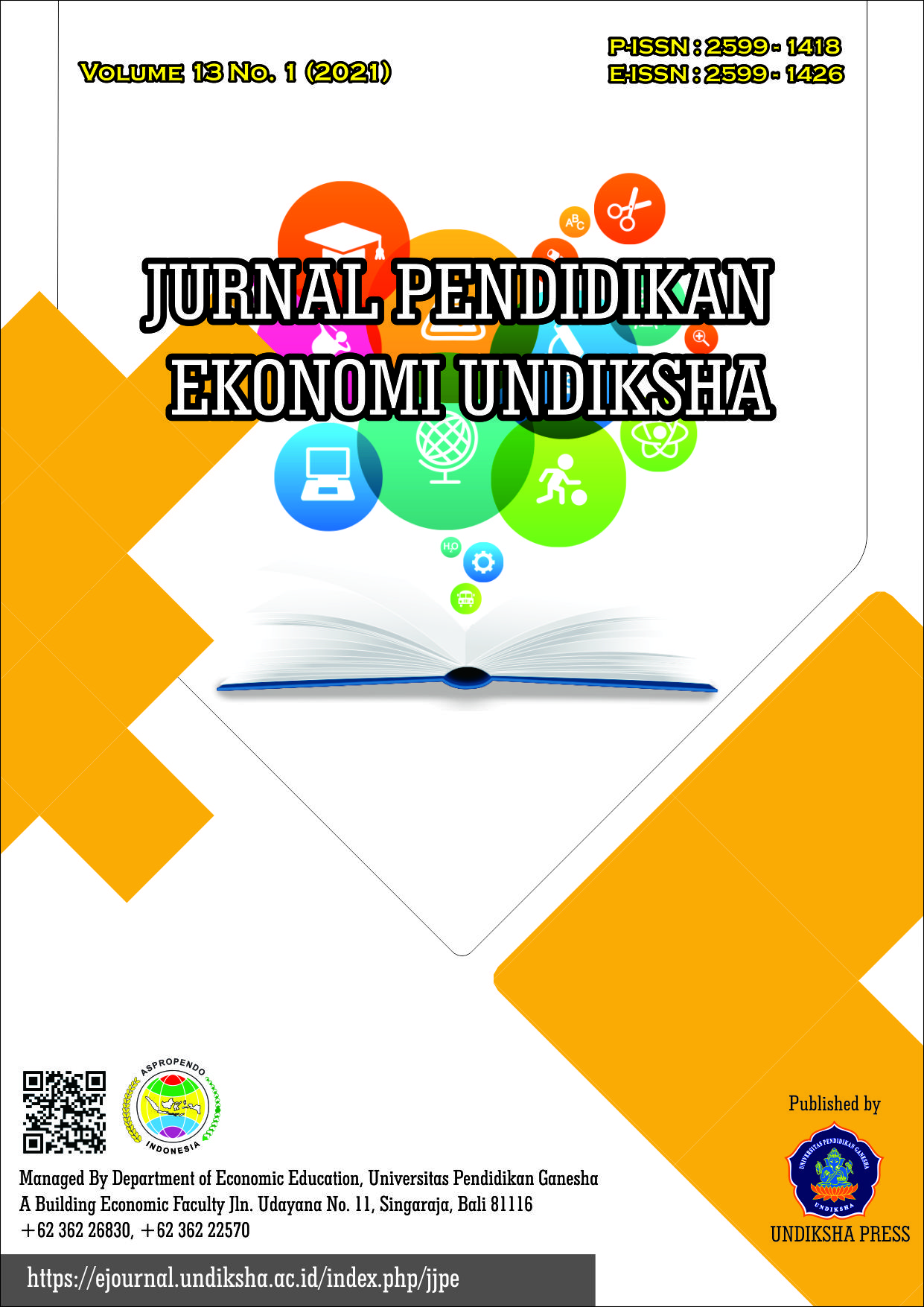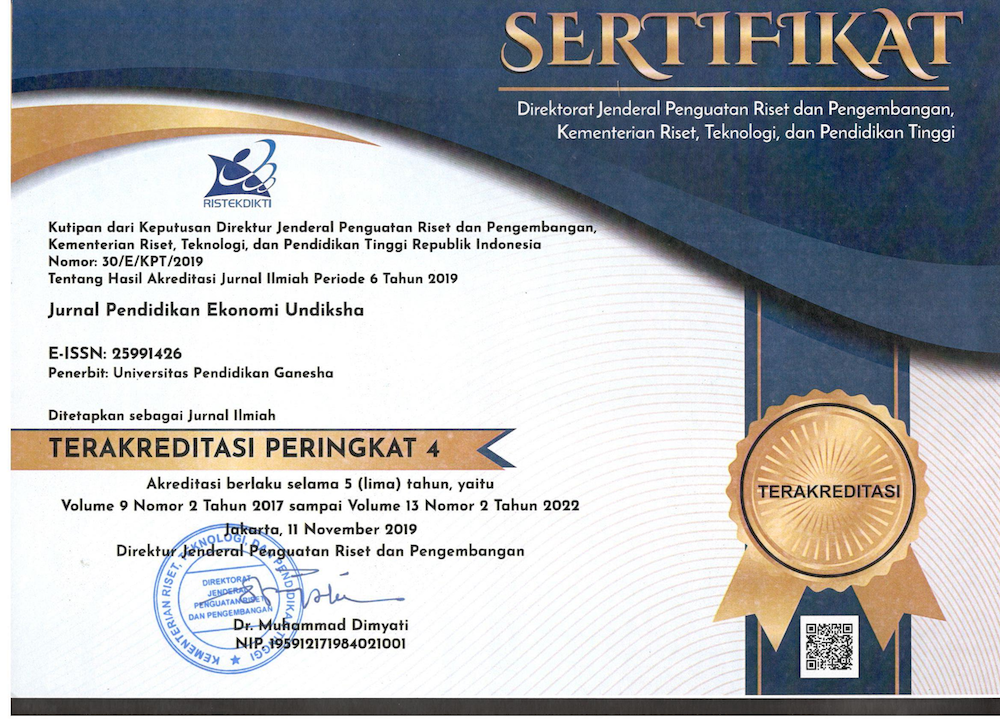Meningkatkan Hasil Belajar Ekonomi Siswa dengan Model Pembelajaran Kooperatif Tipe Mind Mapping
DOI:
https://doi.org/10.23887/jjpe.v13i1.30540Keywords:
learning models, mind mapping, learning outcomes.Abstract
Mind mapping, or the term Mind Mapping and Problem Based Learning, both researchers apply as a model in the examiner class and the monitoring class in this research learning. This research is aimed at notifying whether or not a significant difference can be found between the two or not in economic lessons that are focused on student learning outcomes. In the class of examiners who use Mind Mapping as a model in learning, the researcher uses X IPS 1 in this research. Meanwhile, in the review class that used Problem Based Learning as a model in learning, researchers used X IPS 3 in this research. Quasi-experimental design, or a method that is designed without randomizing the examiner class and the monitoring class in the research and is only given a post-test after being given treatment, otherwise known as the Non-Equivalent Post-Test Only Control Group Design which the researcher uses as this research method. . All students in class X totaled 90 people, each of whom was divided into 3 classes into the population in this research. Sampling technique , known as Simple random samplingSimple Random Sampling, is also the researcher's choice of in this research, from 3 population classes, the researcher chooses X IPS 1 and class X IPS 3 to be the sample. The post-test was chosen as the data collection method, after the post-test data was obtained then the data would be analyzed using a technique from the t test (partial test) which in English is known as the independent sample t-test. Researchers received the results from the computer statistical program SPSS 24.0 for Windows with the results of Sig. (2-tailed) = 0.000. In order to support this research, the significance value must be <0.005, and that means the result of the Significance value in this research is 0.000 <0.005. The results of these researchers used as evidence of acceptance of the research hypothesis in this research, namely that there was a significant difference between student learning outcomes in economic subjects using thetype of cooperative learning model and Mind Mapping student learning outcomes in economic subjects usinglearning models Problem Based Learning in class. X SMA Negeri 3 Singaraja, 2020/2021 academic year.References
Aunurrahman. (2012). Belajar dan Pembelajaran. Bandung: Alfabeta CV.
Darusman, R. (2014). Penerapan Metode Mind Mapping (Peta Pikiran) Untuk Meningkatkan Kemampuan Berpikir Kreatif Matematik Siswa SMP. Infinity Journal, 3(2), 164.
Fauziah, D. N. (2017). Penerapan Model Mind Map Untuk Meningkatkan Kreativitas Dan Pemahaman Siswa Pada Materi Sejarah Kerajaan Islam Di Indonesia. Mimbar Sekolah Dasar, 4(2), 128–138.
Hermaswari, M. S., Meitriana, M. A., & Tripalupi, L. E. (2019). Pengaruh Model Pembelajaran Attention, Relevance, Confidence, and Satisfaction (ARCS) Terhadap Aktivitas Dan Hasil Belajar Ips Terpadu Di Smp N 2 Sawan. Jurnal Pendidikan Ekonomi Undiksha, 10(1), 136.
Nurdyansyah, & Fahyuni, E. F. (2016). Inovasi Pembelajaran Sesuai Kurikulum 2013. Nizamia Learning Center.
Pamungkas, A., Subali, B., & Linuwih, S. (2017). Implementasi model pembelajaran IPA berbasis kearifan lokal untuk meningkatkan kreativitas dan hasil belajar siswa. Jurnal Inovasi Pendidikan IPA, 3(2), 118.
Prahara, R., Wahyono, H., & Utomo, S. (2016). Kualitas Pembelajaran Ekonomi Di Sman Dan Man Malang Raya. Jurnal Pendidikan - Teori, Penelitian, Dan Pengembangan, 1(12), 2266–2271.
Putri, Zuyyina Hasdillah; Ulfah, Maria; Rosyid, R. (2015). Penerapan Model Pembelajaran Mind Mapping Terhadap Hasil Belajar Pada Mata Pelajaran Ekonomi di SMA. 4. No. 11.
Saleh, M. (2013). Strategi Pembelajaran Fiqh Dengan Problem-Based Learning. Jurnal Ilmiah Didaktika, 14(1), 190–220.
Saragih, D. S., & Manurung, N. (2018). Pengaruh Model Mind Map Terhadap Hasil Belajar Siswa Pada Materi Sistem Ekskresi di Kelas XI IPA SMA Swasta Prayatna Medan. Best Journal (Biology Education, Sains and Technology), 1(1), 21–28.
Syam, N., & Ramlah, R. (2015). Penerapan Model Pembelajaran Mind Mapping Dalam Meningkatkan Hasil Belajar Pada Mata Pelajaran Ilmu Pengetahuan Sosial Siswa Kelas Iv Sdn 54 Kota Parepare. Publikasi Pendidikan, 5(3).
Tayeb, T. (2017). Analisis dan Manfaat Model Pembelajaran. Jurnal Pendidikan Dasar Islam, 4(02), 48–55.
Windura, S. (2016). Mind Map Langkah demi Langkah. Elex Media Komputindo.
Yuniharto, B. ., & Susanti, M. M. . (2019). Peningkatan Minat Belajar dan Kreativitas Siswa Kelas IIIA SDN Maguwoharjo 1 Melalui Model Pembelajaran Kooperatif Tipe GI Pada Materi Pertumbuhan dan Perkembangan Tumbuhan. Elementary Journal Vol, 1(2), 22–32.
Zulfia Latifah, A., Hidayat, H., Mulyani, H., Siti Fatimah, A., & Sholihat, A. (2020). Penerapan Metode Mind Mapping Untuk Meningkatkan Kreativitas Pada Pembelajaran Pendidikan Kewarganegaraan. Jurnal Pendidikan, 21(1), 38–50.





